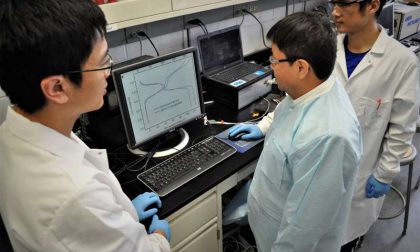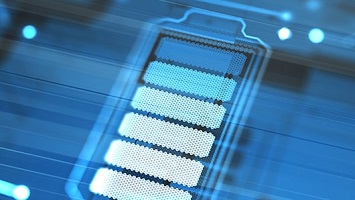
Researchers at the University of Maryland (UMD) and US Army Research Lab (ARL) have taken a critical step on the path to high energy batteries by improving their water-in-salt battery with a new type of chemical transformation of the cathode that creates a reversible solid salt layer, a phenomenon yet unknown in the field of water-based batteries.
Building on their previous discoveries of the water-in-salt electrolytes reported in Science in 2015, the researchers added a new cathode. This new cathode material, lacking transition metal, operates at an average potential of 4.2 volts with excellent cycling stability, and delivers an unprecedented energy density comparable, or perhaps higher than, non-aqueous Li-ion batteries. The authors report their work on May 9 in the journal Nature.
“The University of Maryland and ARL research has produced the most creative new battery chemistry I have seen in at least 10 years,” said Prof. Jeffrey Dahn of Dalhousie University in Canada, an expert in the field not affiliated with the research. “However, it remains to be seen if a practical device with long lifetime can be created.”
Leveraging the reversible halogens intercalation in graphite structures, enabled by a super-concentrated aqueous electrolyte, the team generated an energy density previously thought impossible. The researchers found that the superconcentrated solution of the water-in-salt battery, combined with graphite anode’s ability to automatically build and re-form a protective layer within the battery, gave a stable and long lasting battery with high energy.
“This new cathode chemistry happens to be operating ideally in our previously-developed ‘water-in-salt’ aqueous electrolyte, which makes it even more unique – it combines high energy density of non-aqueous systems with high safety of aqueous systems,” said a co-first author of the paper, Chongyin Yang, an assistant research scientist in the UMD department of chemical & biomolecular engineering.
“This new ‘Conversion-Intercalation’ chemistry inherits the high energy of conversion-reaction and the excellent reversibility from intercalation of graphite,” said Ji Chen, co-first author of the paper and a research associate in the department of chemical & biomolecular engineering.
Read complete article on: Source
Edited and contributed by: S. Marjani
************************
Why Should Be “A Paid-Subscriber” and “Advertiser”
Keeping an independent media in countries that impose limitations on self supporting media, will help to support the humankind’s freedom. If you believe it, please act to be a PRO-MEMBER by clicking “HERE“, or:
Please send your PR’s directly to the email address of the Chief-Editor in order to be published at once in the world via ” http://pimi.ir ” The address is: aasaatnia@live.com.














